
Lesson 2
Artifact or Fiction?
- Time Required: 50-60 minutes
- Curriculum Fits: History, Geography
Lesson Overview
By viewing artifacts, students will connect directly with history. Students will discover that people living on Martha’s Vineyard in the 19th century visited and explored all parts of the world as part of their livelihood. They returned to the island with gifts, tools and objects from faraway places. This activity is aimed at giving students an opportunity to carefully observe images of artifacts and then share what they know with their classmates in a fun way!
Learning Objectives
- Students will demonstrate improved observation skills as they view artifacts that came from whaling voyages.
- Students will locate on a world map where the location of the artifacts.
Materials
- photographs: artifacts from the MVM collection:
- small photographs of artifacts to cut out and place on the map of the world
- large world map
- observation sheet
Procedure
- Share the pictures of the artifacts with the class as a whole. Place them around the room for students to circulate and look at. Have them record their observations on their "observation sheet".
- Divide students into groups of three and given each group a photo of one artifact. Ask each of them to share what they noticed, what they think the artifact is used for and what it is made of.
- After discussing their observations and opinions, have students (quietly) share the information on the back of the card, which gives the real story of what the artifact is (the facts).
- Ask each group to prepare 2 other versions of what their artifact might be to present to the class (the fiction).
- Have each group present their artifact and the three stories, and ask the class is to guess which is the TRUE version!
- After each group presents, have them place the small version of their artifact picture on the world map in the area from which it came.
Authors
Martha Stackpole, Lauren Keaney-Serpa, Elaine Barnett, Kristy Fletcher